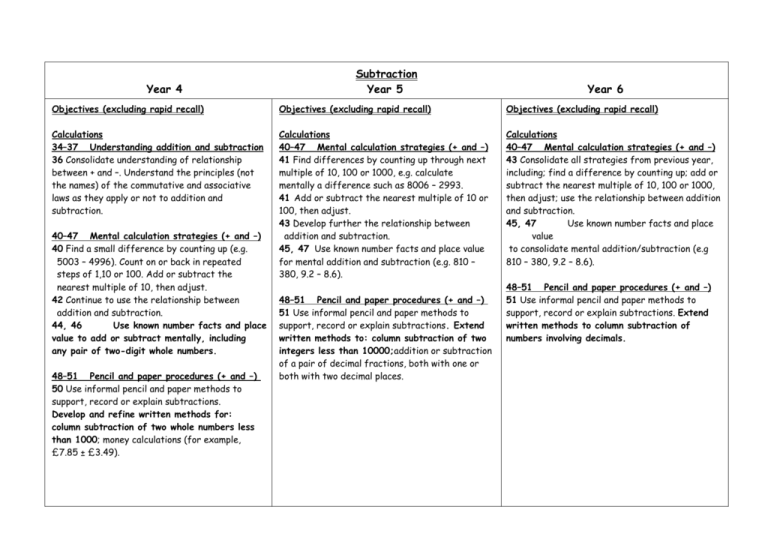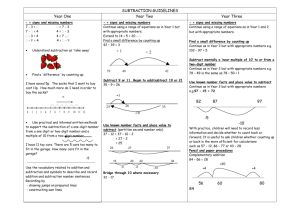Subtraction Year 4 Year 5 Year 6
advertisement

Year 4 Subtraction Year 5 Year 6 Objectives (excluding rapid recall) Objectives (excluding rapid recall) Objectives (excluding rapid recall) Calculations 34–37 Understanding addition and subtraction 36 Consolidate understanding of relationship between + and –. Understand the principles (not the names) of the commutative and associative laws as they apply or not to addition and subtraction. Calculations 40–47 Mental calculation strategies (+ and –) 41 Find differences by counting up through next multiple of 10, 100 or 1000, e.g. calculate mentally a difference such as 8006 – 2993. 41 Add or subtract the nearest multiple of 10 or 100, then adjust. 43 Develop further the relationship between addition and subtraction. 45, 47 Use known number facts and place value for mental addition and subtraction (e.g. 810 – 380, 9.2 – 8.6). Calculations 40–47 Mental calculation strategies (+ and –) 43 Consolidate all strategies from previous year, including; find a difference by counting up; add or subtract the nearest multiple of 10, 100 or 1000, then adjust; use the relationship between addition and subtraction. 45, 47 Use known number facts and place value to consolidate mental addition/subtraction (e.g 810 – 380, 9.2 – 8.6). 40–47 Mental calculation strategies (+ and –) 40 Find a small difference by counting up (e.g. 5003 – 4996). Count on or back in repeated steps of 1,10 or 100. Add or subtract the nearest multiple of 10, then adjust. 42 Continue to use the relationship between addition and subtraction. 44, 46 Use known number facts and place value to add or subtract mentally, including any pair of two-digit whole numbers. 48–51 Pencil and paper procedures (+ and –) 50 Use informal pencil and paper methods to support, record or explain subtractions. Develop and refine written methods for: column subtraction of two whole numbers less than 1000; money calculations (for example, £7.85 ± £3.49). 48–51 Pencil and paper procedures (+ and –) 51 Use informal pencil and paper methods to support, record or explain subtractions. Extend written methods to: column subtraction of two integers less than 10000;addition or subtraction of a pair of decimal fractions, both with one or both with two decimal places. 48–51 Pencil and paper procedures (+ and –) 51 Use informal pencil and paper methods to support, record or explain subtractions. Extend written methods to column subtraction of numbers involving decimals. Subtraction Year 5 Year 4 Year 6 - = signs and missing numbers Continue using a range of equations as in Year 1 and 2 but with appropriate numbers. - = signs and missing numbers Continue using a range of equations as in Year 1 and 2 but with appropriate numbers. Find a small difference by counting up e.g. 5003 – 4996 = 7 This can be modelled on an empty number line (see complementary addition below). Find a difference by counting up e.g. 8006 – 2993 = 5013 This can be modelled on an empty number line (see complementary addition below). Subtract the nearest multiple of 10, then adjust. Continue as in Year 2 and 3 but with appropriate numbers. Use known number facts and place value to subtract 92 – 15 = 67 82 77 Subtract the nearest multiple of 10 or 100, then adjust. Continue as in Year 2, 3 and 4 but with appropriate numbers. Use known number facts and place value to subtract 6.1 – 0.4 = 5.7 6.1 5.7 6.0 92 -0.3 -5 +600 86 100 +14 286 700 754 300 Use known number facts and place value to subtract Continue as year 5 +300 +3467 +54 700 754 OR 754 - 286 = 468 14 (300) 400 (700) 54 (754) 468 0.5 Subtract the nearest multiple of 10, 100 or 1000, then adjust Continue as in Year 2, 3, 4 and 5 but with appropriate numbers. 2684 +54 0.4 0.31 +16 +400 +0.1 +0.09 Pencil and paper procedures Complementary addition 6467 – 2684 = 3783 Pencil and paper procedures Complementary addition 754 – 286 = 468 -10 Pencil and paper procedures Complementary addition 754 – 86 = 668 +14 -0.1 - = signs and missing numbers Continue using a range of equations as in Year 1 and 2 but with appropriate numbers. Find a difference by counting up e.g. 0.5 – 0.31 = 0.19 This can be modelled on an empty number line (see complementary addition below). can be refined to 14 (300) 454 (754) 468 3000 2700 6467 OR 6467 – 2684 = 3783 16 (2700) 300 (3000) 3467 (6467) 3783 can be refined to 316 (3000) 3467 (6467) 3783


